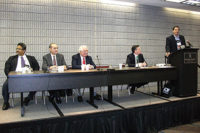Condensing units can be challenging equipment, but proper installation and servicing can minimize such situations. And, as technology continues to advance, the industry is emerging with an extensive list of examples on how to successfully install a condensing unit.
Here are a couple of recent projects.
Sports Bar
Winger’s Sports Bar and Grill in Sydney, Ohio, was looking to reduce energy consumption, limit downtime due to equipment failure, and attract more customers with a comfortable place to spend time.
Bar owners turned to Eck Refrigeration Inc., in Sydney, to recommend energy-saving service practices and new refrigeration technology. The company approached the bar with a plan to compare its current refrigeration equipment to newer technology in a real-world field test location.
The local utility, Dayton Power & Light (DP&L), was also interested in learning about the potential energy savings from this technology. Key personnel at the utility brought in Go Sustainable Energy to conduct preinstallation and post-installation metering of the refrigeration condensing unit manufactured by Emerson Climate Technologies. Metering equipment was installed to measure power, current, and walk-in cooler air temperature.
Back-to-back field tests were conducted during the fall of 2013. The location was instrumented with data acquisition systems that recorded temperatures and power consumption. The old condensing unit was run for several weeks before being replaced with the XJ Series unit. The performance of the two units was compared during periods of similar weather and usage.
The energy efficiency of the entire system was improved beyond initial expectations, according to those involved in the project. The Copeland Scroll™ Outdoor Condensing Unit XJ Series accounted for approximately 23 percent energy-savings when compared to the old unit. Baseline peak demand was 1,645 W, and the energy consumption registered 4,314 kWh per year.
Based on post-installation logged data, the new estimated peak demand is 1,202 W, and the energy consumption will finish at 3,326 kWh per year. This corresponds to a peak demand reduction of 444 W and an annual energy savings of 988 kWh per year.
“The outdoor condensing unit is an important part of our refrigeration energy-savings program,” said Bob Eck, president, Eck Refrigeration.
Health Care
The Kershaw Health Medical Center in Camden, South Carolina, is using energy-efficient dedicated outdoor air condensing systems employing Danfoss VSH variable-speed compressors.
“Today’s hospitals are built to comply with ASHRAE Standard 62-2007, which sets the minimum ventilation requirements for acceptable IAQ,” said Anthony Palucci, director of sales for Annexair Inc., the system manufacturer. “Our goal was to provide a product that could not only meet the outside air requirements, but also provide energy savings.”
The ASHRAE standard requires operating rooms to have 25 air changes per hour. At least five of those air changes must use 100 percent outside air to maintain positive pressure to keep unhealthy air from leaking into the surgical suite. Other hospital areas require two changes per hour to control odors and provide ventilation for comfort. Using a traditional mechanical cooling for that amount of outside air is extremely expensive.
Annexair’s solution revolved around a recuperative dehumidification design in the makeup air-handling systems. Each unit employed a variable-speed compressor to supply a cooling coil used in conjunction with a fixed-plate heat exchanger to recycle thermal energy.
Palucci proposed a dedicated outdoor unit package that takes advantage of a fixed-plate heat exchanger to provide free pre-cooling and reheat functions to handle dehumidification at full load. The variable-speed compressor provides the balance of cooling needed at part-loads.
“This design takes advantage of Camden’s maritime climate,” Palucci said. “In the summer, humidity is high and temperatures average 78?F, peaking in the 90s in July. The heat exchanger does double duty by providing cooling and reheating to dehumidify, using the compressor and cooling coil section as needed during part-load conditions.”
He noted that controlling airborne moisture in the fresh air supplied to the facility is important to control fungus and microbe growth inside. Proper dehumidification control is also important to minimize moisture in the air-handling unit. If ambient air is not properly precooled and reheated, condensation can occur.
Palucci explained that in an air-to-air recuperative unit, outdoor air passes through the fixed-plate heat exchangers twice (two-pass). The heat exchange occurs between the incoming fresh, warm air and the cool air leaving the cooling coil. On the first pass, the fixed plate preconditions the air reaching the cooling coil by reducing the sensible temperature, thereby requiring less mechanical cooling.
At part-load conditions, the compressor supplies the DX coil with the required cooling capacity to drop the sensible temperature even further as needed. The cooling coil maintains a constant leaving-air dew point with the help of the compressor and without the use of hot gas bypass. Then, in the second pass, the cooled air is reheated by absorbing heat from the incoming airstream. Again, as needed, a hot gas reheat coil will raise the sensible temperature to maintain a neutral dry supply air. But, because the heat exchanger is about 65 percent effective in handling both precooling and reheating functions through thermal transfer, electric consumption for additional cooling and reheat is minimized, according to those involved in the project.
Publication date: 6/9/2014
Want more HVAC industry news and information? Join The NEWS on Facebook, Twitter, and LinkedIn today!










